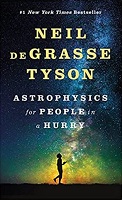Book notes: Astrophysics for People in a Hurry
Mar 15, 2022
By Neil deGrasse Tyson.
I’ve had this book on my radar (in the visible spectrum ;-)) ever since it came out. I enjoy Mr. Tyson’s appearances on television with his amazing grasp on astrophysics, entertaining personality and DEEP BOOMING VOICE. I needed one more book to get free shipping on thriftbooks so tossed this on the order.
This was a great read for me. My view of universe was profoundly changed. There was a large number of interesting random facts and observations thrown in from several decades of study on the subject. It helps to have some some understanding of physics going in. Just because you’re in a hurry doesn’t mean the material is easy to understand. “The universe is under no obligation to make sense to you.” (p13)
He uses a sentence style that I’m always tempted to use but never see where you leave off the subject at the start of a sentence that sounds more natural when speaking, such as “Turned out that in space…” instead of “It turned out that in space…”.
My favorite chapters were the first chapter on the big bang, the dark matter and dark energy chapters, and the cosmic walk through the periodic table.
Notes that I took throughout the book:
- It’s stunning how much we think we know about the big bang, down to trillionths of a second at the start.
- Our universe has Cosmic Microwave Background (CMB) noise. Older, cooler periods have lower wavelengths.
- There’s a lot of stuff between the stars in our universe. e.g. cosmic rays, gas clouds, dust.
- Distances:
- Atmosphere: ~3k miles (depending on definition).
- Geo-station orbit: 26k miles (1/10 to the moon).
- Next galaxies: 600 light years.
- Visible matter only accounts for 5% of all mass-energy, dark matter is 27%, dark energy is 68%. We don’t really know what dark matter & energy really are.
- Thunderstorms generate gamma rays that are detected by space satellites.
- Jupiter acts as a gravitational shield for meteors.
- Supernova stars release the same amount of energy over the same amount of time so are good “standard candles”.
- Supernovas that are further away are travelling away from us at a faster rate than closer ones. Because of this, Mr. Tyson’s “recurring nightmare” is that a trillion years from now we will have a lot less information in our universe to work with.
- We study the universe on all wavelengths now, not just visible light.
I would highly recommend this book to others, though I doubt my family would find it that interesting. It will probably go in a neighborhood little library.